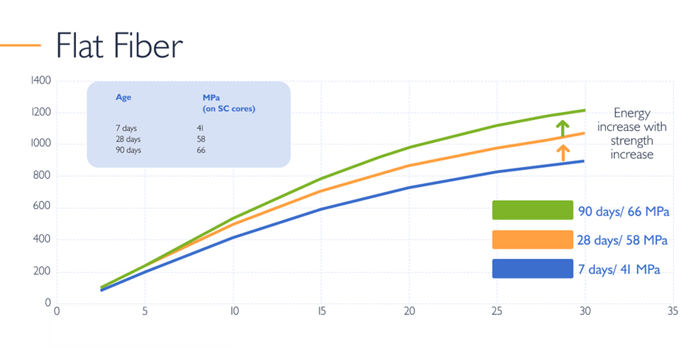Roland Mayr, our expert and Global Technical Manager for Sprayed Concrete, will guide you in this series on how to choose the right structural synthetic fibers for sprayed concrete. The process of selection depends on the timing and method of loading the concrete.
The performance of pp fibers depends on the fiber strength and the properties of the interface between the fiber and the concrete matrix. This is influenced by both the surface structure of the fiber (flat, embossed) and the strength (age) of the matrix.
Energy absorption panels (EA)
The age at which energy absorption panels are tested varies from country to country, from 7 to 28 days. The testing can be done either when a certain strength is reached or at a certain age. It should be noted that, if a shotcrete shell is loaded a long time after it is applied, the strength and performance can be quite different than if it is loaded immediately.
Ideally, a fiber should not be pulled out easily or break as a load is applied. Fibers should only start to pull out as the maximum breaking load of the concrete lining approaches.
Flat versus embossed
To compare the performance of flat and embossed fibers in different strengths and ages of concrete, tests were carried out on square panels at 7, 28 and 90 days. (Round test panels are often used in mining but results from square panels can be converted to those obtained from round panels by dividing the EA obtained by 2.5).
The performance of the flat fibers can be seen in the chart below. With increasing age and strength of the concrete, the performance of the system improves.
Graphic 1: Performance of flat fiber at 6 kg/m3 in square panel test

The embossed fibers show a different behavior. The performance in the lower deformation range is very similar. In the higher deformation range and with increasing concrete strength and age the performance decreases.
This is the second article in a series about fibers in sprayed concrete by Roland. If you missed the first article, you can find it here.
Graphic 2: Performance of embossed fiber at 6 kg/m3 in panel test

After the tests, the fibers in the cracks were counted and classified into snapped and pulled-out fibers. The percentage of snapped fibers increases with strength/age for both fiber types, but the increase of broken embossed fibers is significantly higher.
The following conclusions can be drawn from these results:
- Modern sprayed concrete tends to develop significant strength with age.
- It is important to consider at what age the sprayed concrete will be loaded and the size of the deformations.
- Flat fibers can take higher loads and deformations, as long as the loads are applied when the concrete has reached a higher age/strength.
- Embossed fibers can be better for lower age/strength concrete (up to 14 days). Also, they provide greater stiffness with lower overall levels of deformation.
Master Builders Solutions provides various types of MasterFiber structural pp fibers. Our knowledge of concrete technology and chemistry allows us to design the concrete mix and select the fibers for a maximum structural response, based on the geology of the underground.
For reinforced sprayed concrete, the main requirement is to maintain a certain level of ductility under high deformation conditions. The strength and age of the concrete matrix, as well as the fiber type, must be considered to achieve the desired performance.
To read Roland's initial article on this topic, please click here.
/in%20USE/Roland%20Mayr%20(2).jpg)
Roland Mayr


